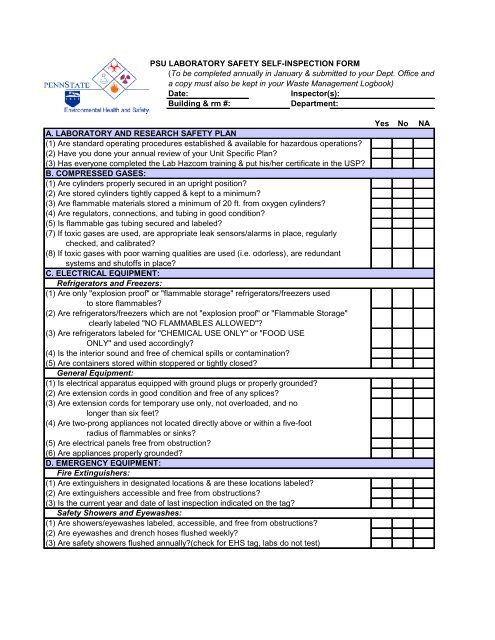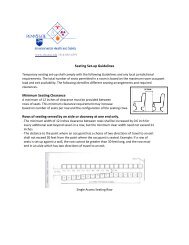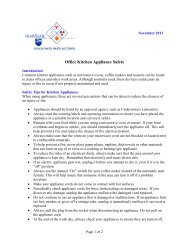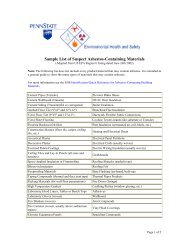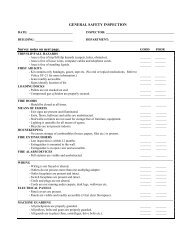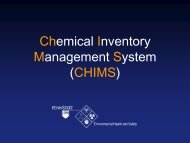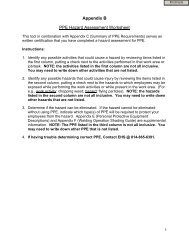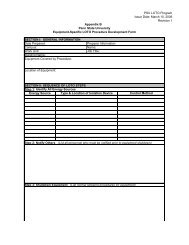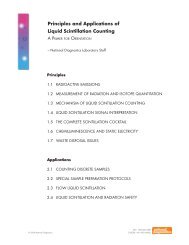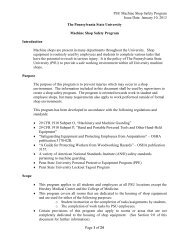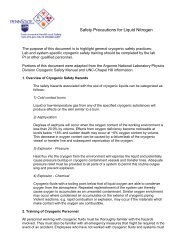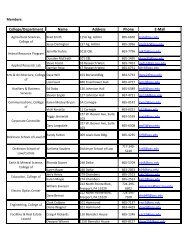Laboratory Self Inspection Form
Laboratory Self Inspection Form
Laboratory Self Inspection Form
You also want an ePaper? Increase the reach of your titles
YUMPU automatically turns print PDFs into web optimized ePapers that Google loves.
PSU LABORATORY SAFETY SELF-INSPECTION FORM<br />
(To be completed annually in January & submitted to your Dept. Office and<br />
a copy must also be kept in your Waste Management Logbook)<br />
Date:<br />
Inspector(s):<br />
Building & rm #:<br />
Department:<br />
A. LABORATORY AND RESEARCH SAFETY PLAN<br />
(1) Are standard operating procedures established & available for hazardous operations?<br />
(2) Have you done your annual review of your Unit Specific Plan?<br />
(3) Has everyone completed the Lab Hazcom training & put his/her certificate in the USP?<br />
B. COMPRESSED GASES:<br />
(1) Are cylinders properly secured in an upright position?<br />
(2) Are stored cylinders tightly capped & kept to a minimum?<br />
(3) Are flammable materials stored a minimum of 20 ft. from oxygen cylinders?<br />
(4) Are regulators, connections, and tubing in good condition?<br />
(5) Is flammable gas tubing secured and labeled?<br />
(7) If toxic gases are used, are appropriate leak sensors/alarms in place, regularly<br />
checked, and calibrated?<br />
(8) If toxic gases with poor warning qualities are used (i.e. odorless), are redundant<br />
systems and shutoffs in place?<br />
C. ELECTRICAL EQUIPMENT:<br />
Refrigerators and Freezers:<br />
(1) Are only "explosion proof" or "flammable storage" refrigerators/freezers used<br />
to store flammables?<br />
(2) Are refrigerators/freezers which are not "explosion proof" or "Flammable Storage"<br />
clearly labeled "NO FLAMMABLES ALLOWED"?<br />
(3) Are refrigerators labeled for "CHEMICAL USE ONLY" or "FOOD USE<br />
ONLY" and used accordingly?<br />
(4) Is the interior sound and free of chemical spills or contamination?<br />
(5) Are containers stored within stoppered or tightly closed?<br />
General Equipment:<br />
(1) Is electrical apparatus equipped with ground plugs or properly grounded?<br />
(2) Are extension cords in good condition and free of any splices?<br />
(3) Are extension cords for temporary use only, not overloaded, and no<br />
longer than six feet?<br />
(4) Are two-prong appliances not located directly above or within a five-foot<br />
radius of flammables or sinks?<br />
(5) Are electrical panels free from obstruction?<br />
(6) Are appliances properly grounded?<br />
D. EMERGENCY EQUIPMENT:<br />
Fire Extinguishers:<br />
(1) Are extinguishers in designated locations & are these locations labeled?<br />
(2) Are extinguishers accessible and free from obstructions?<br />
(3) Is the current year and date of last inspection indicated on the tag?<br />
Safety Showers and Eyewashes:<br />
(1) Are showers/eyewashes labeled, accessible, and free from obstructions?<br />
(2) Are eyewashes and drench hoses flushed weekly?<br />
(3) Are safety showers flushed annually?(check for EHS tag, labs do not test)<br />
Yes No NA
First Aid:<br />
(1) Are first aid kits stored in designated areas?<br />
(2) Is the kit properly stocked according to University Policy SY-21?<br />
E. HAZARDOUS SUBSTANCES:<br />
Chemical Storage:<br />
(1) Has chemical inventory been updated annually in CHIMS?<br />
(2) Are chemicals dated upon receipt?<br />
(3) Are chemical containers labeled, capped, and in good condition?<br />
(4) Is the storage of chemicals on, above, or next to a desk avoided?<br />
(5) Are all corrosive chemicals stored below "eye level"?<br />
(6) Are chemicals segregated by hazard (organics away from oxidizers,<br />
flammables away from acids)?<br />
(7) Is chemical storage kept to a minimum?<br />
Solvent Storage:<br />
(1) Is excess solvent stored in approved safety cans or solvent storage<br />
cabinets and not placed high on shelving?<br />
(2) Are approved safety cans equipped with self-closing lids and are flame<br />
arrestors intact?<br />
(3) Are safety can lids closed?<br />
(4) Are safety cans/wash bottles properly labeled?<br />
Infectious/Chemical Waste:<br />
(1)Designated Chemical Accumulation area with room and bldg. listed in log book?<br />
(2) Are waste containers labeled and chemical compositions identified?<br />
(3) Are waste areas inspected weekly and documentation maintained?<br />
(4) Is waste stored in secondary containment?<br />
(5) Have waste area overseer and Supervisor been designated?<br />
(6) Is total volume of all chemical waste < 55 gallons?<br />
(7) Are biohazard containers properly used where needed (i.e. autoclave<br />
bags, sharps containers)?<br />
<strong>Laboratory</strong> Hoods/Local Exhaust:<br />
(1) Are exhaust hoods working properly? (Confirm date of last inspection).<br />
(2) Do hood sashes open/close properly and is glass intact?<br />
(3) Is hood free of excess chemical storage/equipment?<br />
(4) Are hood sashes down (panels closed) when not accessing?<br />
F. PROTECTIVE EQUIPMENT:<br />
Personal Equipment:<br />
(1) Are safety glasses with side shields worn as required?<br />
(2) Are substantial shoes worn with no sandals or open toes?<br />
(3) Is protective clothing worn while working at benches?<br />
(4) Are gloves selected and worn according to hazard?<br />
(5) Are chemical splash goggles/face shields worn when appropriate?<br />
Other Equipment:<br />
(1) Is proper protective equipment in place (shields,guards, warning signs,etc?<br />
(2) Is secondary containment used for Hg use and storage?<br />
General Housekeeping:<br />
(1) Are aisles and exits free from obstructions?<br />
(2) Are benches/shelves not overloaded with unused equipment/chemicals?<br />
(3) Are no combustibles stored within three feet of the ceiling?<br />
(4) Is no damaged glassware in use (i.e. broken or chipped)?<br />
(5) Is lab apparatus properly assembled and used in a safe manner?<br />
(6) Are bicycles not stored in lab?<br />
Yes No NA
G. SIGNS:<br />
(1) Are special hazard signs in place (i.e. lasers, cryogenic hazards, biohazards)?<br />
(2) Are lab doors labeled and information up-to-date?<br />
H. TRAINING:<br />
(1) Have lab personnel been instructed in potential hazards and lab safety practices?<br />
(3) Have all personnel in lab (including PI) received initial <strong>Laboratory</strong> Safety training?<br />
(4) Have all personnel in lab (including PI) completed the lab safety mandatory refresher<br />
training?<br />
(5) Has a copy of the training records been sent to your Dept. office?<br />
I. VACUUM EQUIPMENT:<br />
(1) Are vacuum pump belt guards in place?<br />
(2) Are glass Dewars wrapped or shielded?<br />
(3) Are protective shatterproof shields in place when vacuum equip. is used?<br />
(4) Are glass desiccators under vacuum stored in metal guards or shielded?<br />
J. SECURITY (PSU POLICY SY-24):<br />
(1) Are radioactive, biohazardous material, and hazardous materials secured from<br />
unauthorized removal?<br />
(2) Is lab familiar with PSU Policy SY-24 Use of Biohazardous Materials in Research<br />
and Instruction and conducting annual inventory of materials regulated<br />
by this policy?<br />
Yes No NA<br />
_______________________________________________________________________<br />
Name of Principal Investigator (print)<br />
Signature of Principal Investigator<br />
_______________________________________________________________________<br />
Name of Department Head (print)<br />
Signature of Department Head
t. Office and


